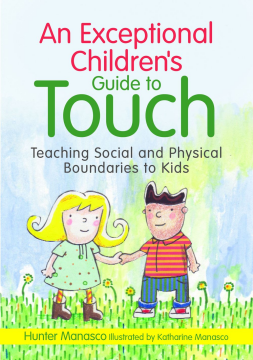
Additional Information
Book Details
Abstract
The rules of physical contact can be tricky to grasp and children with special needs are at a heightened risk of abuse. This friendly picture book explains in simple terms how to tell the difference between acceptable and inappropriate touch, thereby helping the child with special needs stay safe.
Each story covers a different type of touch from accidental to friendly to hurtful and will help children understand how boundaries change depending on the context. It explores when and where it is okay to touch other people, when and where other people can touch you, why self touching sometimes needs to be private, and what to do if touch feels inappropriate.
This book is an invaluable teaching resource and discussion starter for parents, teachers and carers working with children with special needs.
It helpfully introduces the idea of inappropriate touch from other people and ways of staying safe without being scary or embarrassing. This is an ideal book to read and discuss with primary school children with autism and also suitable for older children.
Aukids
This is a beautifully illustrated, succinct, collection of short stories that can help young children gain insight into acceptable and unacceptable physical contact. Teaching any child how to self-advocate can be tricky, however, Hunter Manasco's An Exceptional Children's Guide to Touch provides wonderful visual instructions and a gateway for discussion about this delicate subject. Child maltreatment is endemic, and I applaud Manasco's matter-of-fact, presentation of this topic. His book speaks to the needs of all young children and vulnerable adults, trying to navigate their way through our complex and confusing sexual jungle. An Exceptional Children's Guide to Touch is an excellent resource for 'parents, teachers and other adults' working with young children and exceptional people.
Jane Whelen Banks, MHSt, FNP, author of The Loveable Liam series
This is an excellent book which would be very useful for parents and professionals working with vulnerable young children.
SEN Magazine
Hunter Manasco Ph.D. is an assistant professor in the department of speech-language pathology at Misericordia University. He specializes in treating autism and neurological disorders in pediatric and adult populations and has extensive professional experience of working with children with special needs in schools, hospitals and university clinics.
An Exceptional Children's Guide to Touch will be of great use to anyone involved with children that have any learning or development need. The combined use of Hunter's text and Katharine's illustrations has created a wonderful resource to help navigate the complexities of social rules and norms regarding physical interactions, traditionally a sensitive area to broach. This book could be used with an individual child or within a group setting and would be a valuable addition to all parents', carers' and professionals' libraries.
Jackie Bateman, child protection specialist (sexually harmful behaviour) and children's services manager, Barnardo's The Junction
This superbly crafted book teaches the child with special needs about the complexity of touching without denying them the affection and reassurance that touch can give. Its child friendly language and illustrations are perfect in explaining inappropriate touch without being frightening or embarrassing. In a nutshell, it provides clear and simple guidelines, backed up by the reassurance that a trusted adult is always on hand to help if there is any confusion. This book cannot fail to touch a chord with parents and professionals alike in its exceptionally brilliant simplicity.
K.I. Al-Ghani, experienced specialist advisory teacher, autism trainer and author of The Red Beast
Clearly illustrated, with a healthy dose of appropriate humour for a potentially awkward and embarrassing subject matter, this book is brilliantly plain and simple. The illustrations will help children, parents and practitioners to convey the social norms that surround and govern physical interactions, without denying children the affection and reassurance that appropriate touch can give.
Early Years Educator (eye)
Table of Contents
| Section Title | Page | Action | Price |
|---|---|---|---|
| An Exceptional Children’sGuide to Touch: Teaching Social and Physical Boundaries to Kids | ii | ||
| 1. Accidental touch | viii | ||
| 2. Friendly touch | 9 | ||
| 3. Hurtful touch | 21 | ||
| 4. Touching myself | 30 | ||
| 5. Not touching | 40 | ||
| 6. Having mypicture taken | 52 | ||
| Keeping Children with Special Needs Safe | 58 | ||
| Blank Page | c |
